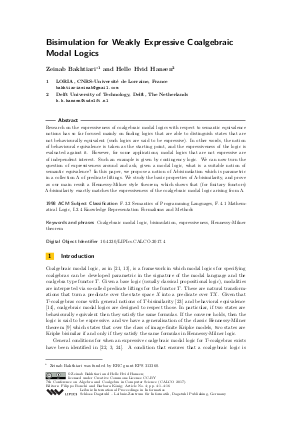Bisimulation for Weakly Expressive Coalgebraic Modal Logics
Authors Zeinab Bakhtiari, Helle Hvid Hansen
-
Part of:
Volume:
7th Conference on Algebra and Coalgebra in Computer Science (CALCO 2017)
Part of: Series: Leibniz International Proceedings in Informatics (LIPIcs)
Part of: Conference: Conference on Algebra and Coalgebra in Computer Science (CALCO) - License:
 Creative Commons Attribution 3.0 Unported license
Creative Commons Attribution 3.0 Unported license
- Publication Date: 2017-11-17
File

PDF
LIPIcs.CALCO.2017.4.pdf
- Filesize: 0.49 MB
- 16 pages
Document Identifiers
Subject Classification
Keywords
- Coalgebraic modal logic
- bisimulation
- expressiveness
- Hennessy-Milner theorem
Metrics
- Access Statistics
-
Total Accesses (updated on a weekly basis)
0Document
0Metadata
Abstract
Research on the expressiveness of coalgebraic modal logics with respect to semantic equivalence notions has so far focused mainly on finding logics that are able to distinguish states that are not behaviourally equivalent (such logics are said to be expressive). In other words, the notion of behavioural equivalence is taken as the starting point, and the expressiveness of the logic is evaluated against it. However, for some applications, modal logics that are not expressive are of independent interest. Such an example is given by contingency logic. We can now turn the question of expressiveness around and ask, given a modal logic, what is a suitable notion of semantic equivalence? In this paper, we propose a notion of \Lambda-bisimulation which is parametric in a collection \Lambda of predicate liftings. We study the basic properties of \Lambda-bisimilarity, and prove as our main result a Hennessy-Milner style theorem, which shows that (for finitary functors) \Lambda-bisimilarity exactly matches the expressiveness of the coalgebraic modal logic arising from \Lambda.
Cite As Get BibTex
Zeinab Bakhtiari and Helle Hvid Hansen. Bisimulation for Weakly Expressive Coalgebraic Modal Logics. In 7th Conference on Algebra and Coalgebra in Computer Science (CALCO 2017). Leibniz International Proceedings in Informatics (LIPIcs), Volume 72, pp. 4:1-4:16, Schloss Dagstuhl – Leibniz-Zentrum für Informatik (2017)
https://doi.org/10.4230/LIPIcs.CALCO.2017.4
BibTex
@InProceedings{bakhtiari_et_al:LIPIcs.CALCO.2017.4,
author = {Bakhtiari, Zeinab and Hvid Hansen, Helle},
title = {{Bisimulation for Weakly Expressive Coalgebraic Modal Logics}},
booktitle = {7th Conference on Algebra and Coalgebra in Computer Science (CALCO 2017)},
pages = {4:1--4:16},
series = {Leibniz International Proceedings in Informatics (LIPIcs)},
ISBN = {978-3-95977-033-0},
ISSN = {1868-8969},
year = {2017},
volume = {72},
editor = {Bonchi, Filippo and K\"{o}nig, Barbara},
publisher = {Schloss Dagstuhl -- Leibniz-Zentrum f{\"u}r Informatik},
address = {Dagstuhl, Germany},
URL = {https://drops.dagstuhl.de/entities/document/10.4230/LIPIcs.CALCO.2017.4},
URN = {urn:nbn:de:0030-drops-80500},
doi = {10.4230/LIPIcs.CALCO.2017.4},
annote = {Keywords: Coalgebraic modal logic, bisimulation, expressiveness, Hennessy-Milner theorem}
}
Author Details
References
-
J. Adámek and H. Porst. From varieties of algebras to covarieties of coalgebras. In CMCS 2000, volume 44 of Electr. Notes in Theor. Comp. Sci., pages 27-46. Elsevier, 2001.

-
Z. Bakhtiari, H. van Ditmarsch, and H.H. Hansen. Neighbourhood contingency bisimulation. In ICLA 2017, volume 10119 of LNCS, pages 48-63. Springer, 2017.

-
M. Bílková and M. Dostál. Expressivity of many-valued modal logics, coalgebraically. In WoLLIC 2016, volume 9803 of LNCS, pages 109-124. Springer, 2016.

-
S. Enqvist. Homomorphisms of coalgebras from predicate liftings. In CALCO 2013, volume 8089 of LNCS, pages 126-140. Springer, 2013.

-
J. Fan and H. van Ditmarsch. Neighborhood contingency logic. In ICLA 2015, volume 8923 of LNCS, pages 88-99. Springer, 2015.

-
J. Fan, Y. Wang, and H. van Ditmarsch. Almost necessary. In AiML 2014, pages 178-196. College Publications, 2014.

-
D. Gorín and L. Schröder. Simulations and bisimulations for coalgebraic modal logics. In CALCO 2013, volume 8089 of LNCS, pages 253-266. Springer, 2013.

-
H.H. Hansen, C. Kupke, and E. Pacuit. Neighbourhood structures: Bisimilarity and basic model theory. Logical Methods in Computer Science, 5(2:2), 2009.

-
M. Hennessy and R. Milner. Algebraic laws for non-determinism and concurrency. Journal of the ACM, 32:137-161, 1985.

-
B. Jacobs and A. Sokolova. Exemplaric expressivity of modal logics. Journal of logic and computation, 20(5):1041-1068, 2010.

-
B. Klin. Coalgebraic modal logic beyond sets. Electronic Notes in Theoretical Computer Science, 173:177-201, 2007.

-
C. Kupke and R.A. Leal. Characterising behavioural equivalence: Three sides of one coin. In CALCO 2009, volume 5728 of LNCS, pages 97-112. Springer, 2009.

-
C. Kupke and D. Pattinson. Coalgebraic semantics of modal logics: an overview. Theoretical Computer Science, 412(38):5070-5094, 2011.

-
A. Kurz. Logics for coalgebras and applications to computer science. PhD thesis, Ludwig-Maximilians-Universität München, 2000.

-
P.B. Levy. Similarity quotients as final coalgebras. In FoSSaCS 2011, volume 6604 of LNCS, pages 27-41. Springer, 2011.

-
T. Litak, D. Pattinson, K. Sano, and L. Schröder. Coalgebraic predicate logic. In ICALP 2012, volume 7392 of LNCS, pages 299-311. Springer, 2012.

-
S. Mac Lane. Categories for the working mathematician, volume 5. Springer Science &Business Media, 2013.

-
J. Marti and Y. Venema. Lax extensions of coalgebra functors and their logic. Journal of Computer and System Sciences, 81(5):880-900, 2015.

-
H. Montgomery and R. Routley. Contingency and non-contingency bases for normal modal logics. Logique et Analyse, 9:318-328, 1966.

-
L. Moss and I. Viglizzo. Harsanyi type spaces and final coalgebras constructed from satisfied theories. In CMCS 2004, volume 106 of Electr. Notes in Theor. Comp. Sci., pages 279-295. Elsevier, 2004.

-
D. Pattinson. Coalgebraic modal logic: Soundness, completeness and decidability of local consequence. Theoretical Computer Science, 309(1-3):177-193, 2003.

-
D. Pattinson et al. Expressive logics for coalgebras via terminal sequence induction. Notre Dame Journal of Formal Logic, 45(1):19-33, 2004.

-
J.J.M.M. Rutten. Universal coalgebra: a theory of systems. Theoretical Computer Science, 249(1):3-80, 2000.

-
L. Schröder. Expressivity of coalgebraic modal logic: The limits and beyond. Theoretical Computer Science, 390:230-247, 2008.

-
J. van Benthem, N. Bezhanishvili, S. Enqvist, and J. Yu. Instantial neighbourhood logic. Review of Symbolic Logic, 10(1):116-144, 2017.

